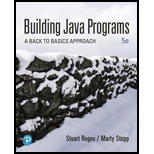
Concept explainers
Explanation of Solution
Program code:
commonNames.java
//import the required packages
import java.io.File;
import java.util.Arrays;
import java.util.Scanner;
//define a class commonNames
public class commonNames
{
//define the main
public static void main(String[] args) throws Exception
{
//create the object of File class
File fileName = new File("file.txt");
//create the object of Scanner class to refer the file
Scanner input = new Scanner(fileName);
//call the method mostCommonNames()
mostCommonNames(input);
}
//define the method mostCommonNames()
public static int mostCommonNames(Scanner input)
{
//declare an integer variable
int uniqueName=0;
//itrerate while loop to get the lines of the file
while(input.hasNextLine())
{
//create a string variable and get the lines to it
String line=input.nextLine();
//create the variable of Scanner
Scanner console=new Scanner (line);
//create a string and get the tokens to it
String last=console.next();
//increment the variable uniqueName by 1
uniqueName++;
//create a string variable and assign last to it
String commonWord=last;
//create two integer variables
int mostCommon=1;
int count=1;
//iterate a while loop to get the tokens
while(console.hasNext()
{
//create a string variable current and get the token to it
String current=console.next();
//if the value of current and last are equal
if(current.equals(last))
{
//increment the count by 1
count++;
}
//if the value of current and last are not equal
else
{
//if the count is greater than mostCommon
if(count>mostCommon)
{
//Assign the value of count to mostCommon
mostCommon=count;
//Assign the value of last to mostCommon
commonWord=last;
}
//set the value of count as 1
count=1;
//increment the value of uniqueName by 1
uniqueName++;
}
//assign the value of current to last
last=current;
}
//if count is greater than mostCommon
if(count>mostCommon)
{
//assign last to commonWord
commonWord=last;
}
//print the commonWord
System...
Want to see the full answer?
Check out a sample textbook solution
Chapter 6 Solutions
MyProgrammingLab with Pearson eText -- Access Code Card -- for Building Java Programs
- For this question you will perform two levels of quicksort on an array containing these numbers: 59 41 61 73 43 57 50 13 96 88 42 77 27 95 32 89 In the first blank, enter the array contents after the top level partition. In the second blank, enter the array contents after one more partition of the left-hand subarray resulting from the first partition. In the third blank, enter the array contents after one more partition of the right-hand subarray resulting from the first partition. Print the numbers with a single space between them. Use the algorithm we covered in class, in which the first element of the subarray is the partition value. Question 1 options: Blank # 1 Blank # 2 Blank # 3arrow_forward1. Transform the E-R diagram into a set of relations. Country_of Agent ID Agent H Holds Is_Reponsible_for Consignment Number $ Value May Contain Consignment Transports Container Destination Ф R Goes Off Container Number Size Vessel Voyage Registry Vessel ID Voyage_ID Tonnagearrow_forwardI want to solve 13.2 using matlab please helparrow_forward
- a) Show a possible trace of the OSPF algorithm for computing the routing table in Router 2 forthis network.b) Show the messages used by RIP to compute routing tables.arrow_forwardusing r language to answer question 4 Question 4: Obtain a 95% standard normal bootstrap confidence interval, a 95% basic bootstrap confidence interval, and a percentile confidence interval for the ρb12 in Question 3.arrow_forwardusing r language to answer question 4. Question 4: Obtain a 95% standard normal bootstrap confidence interval, a 95% basic bootstrap confidence interval, and a percentile confidence interval for the ρb12 in Question 3.arrow_forward
 Database System ConceptsComputer ScienceISBN:9780078022159Author:Abraham Silberschatz Professor, Henry F. Korth, S. SudarshanPublisher:McGraw-Hill Education
Database System ConceptsComputer ScienceISBN:9780078022159Author:Abraham Silberschatz Professor, Henry F. Korth, S. SudarshanPublisher:McGraw-Hill Education Starting Out with Python (4th Edition)Computer ScienceISBN:9780134444321Author:Tony GaddisPublisher:PEARSON
Starting Out with Python (4th Edition)Computer ScienceISBN:9780134444321Author:Tony GaddisPublisher:PEARSON Digital Fundamentals (11th Edition)Computer ScienceISBN:9780132737968Author:Thomas L. FloydPublisher:PEARSON
Digital Fundamentals (11th Edition)Computer ScienceISBN:9780132737968Author:Thomas L. FloydPublisher:PEARSON C How to Program (8th Edition)Computer ScienceISBN:9780133976892Author:Paul J. Deitel, Harvey DeitelPublisher:PEARSON
C How to Program (8th Edition)Computer ScienceISBN:9780133976892Author:Paul J. Deitel, Harvey DeitelPublisher:PEARSON Database Systems: Design, Implementation, & Manag...Computer ScienceISBN:9781337627900Author:Carlos Coronel, Steven MorrisPublisher:Cengage Learning
Database Systems: Design, Implementation, & Manag...Computer ScienceISBN:9781337627900Author:Carlos Coronel, Steven MorrisPublisher:Cengage Learning Programmable Logic ControllersComputer ScienceISBN:9780073373843Author:Frank D. PetruzellaPublisher:McGraw-Hill Education
Programmable Logic ControllersComputer ScienceISBN:9780073373843Author:Frank D. PetruzellaPublisher:McGraw-Hill Education





